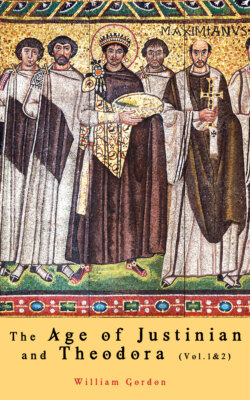Читать книгу The Age of Justinian and Theodora (Vol.1&2) - William Gordon Holmes - Страница 10
На сайте Литреса книга снята с продажи.
ОглавлениеDiagram of CP. in 6th century.
Latitude 41° N. (Nearly level with Naples and Madrid)
Rome was divided by Augustus into fourteen regions or parishes, to each of which he appointed a body of public officers whose functions much resembled those of a modern Vestry.357 The municipal government of the new Rome is an almost exact imitation of that instituted by the founder of the Empire for the old capital. Here are the same number of regions, named numerically and counted in order from east to west, beginning at the end of the promontory. The last two of these, however, are outside the wall of Constantine, that is to say, Blachernae on the north-west and Sycae over the water. To each division is assigned a Curator or chief controller, a Vernaculus or beadle, who performs the duties of a public herald, five Vicomagistri, who form a night patrol for the streets, and a considerable number of Collegiati, in the tenth region as many as ninety, whose duty it is to rush to the scene of fires with hatchets and water-buckets.358 At night the main thoroughfares are well lighted by flaring oil-lamps.359
One remarkable feature of the city, to be encountered by the visitor at every turn, is an elevated shed which can be approached on all sides by ranges of steps. These “Steps,” as they are briefly called, are stations for the gratuitous daily distribution of provisions to the poorer citizens. Every morning a concourse of the populace repairs to the Step attached to their district, and each person, on presenting a wooden tessera or ticket, inscribed with certain amounts, receives a supply of bread, and also a dole of oil, wine, and flesh.360 More than six score of such stations are scattered throughout the town, and the necessary corn is stored in large granaries which are for the most part replenished by ships arriving every season from Alexandria.361 More than twenty public bakeries furnish daily the required demand of bread.362 Besides free grants of food and houses for the entertainment of strangers, the city contains various other charities under the direction of state officials, the chief of which are hospitals for the sick and aged, orphanages, poor-houses, and institutions for the reception of foundlings.363 A medical officer, entitled an arch-physician, with a public stipend, is attached to each parish to attend gratuitously to the poor.364
The civic authorities are well aware that disease arises from putrid effluvia, and hence an elaborate system of deep drainage has been constructed so that all sewage is carried by multiple channels into the sea.365 Since the introduction of Christianity, cremation has become obsolete, and burial in the earth is universally practised.366 Public cemeteries, however, are not allowed within the walls, but churches and monasteries are permitted to devote a portion of their precincts to the purpose of interment. Such limited space is necessarily reserved for members of the hierarchy and persons of a certain rank, who have been beneficiaries of the church or order.367
We may here terminate our exploration of the topography of Constantinople, content to leave a multitude of objects, both interesting and important, beyond the limits of our survey. Were I to attempt the description of everything worthy of notice in the city, my exposition would soon resemble the catalogue of a museum, and the reader’s attention would expire under the sense of interminable enumerations. Our picture has been filled in with sufficient detail to convey the impression of a vast capital laid out in colonnaded squares and streets, to the adornment of which all that Grecian art could evolve in architecture and statuary has been applied with a lavishness attainable only by the fiat of a wide-ruling despot.
